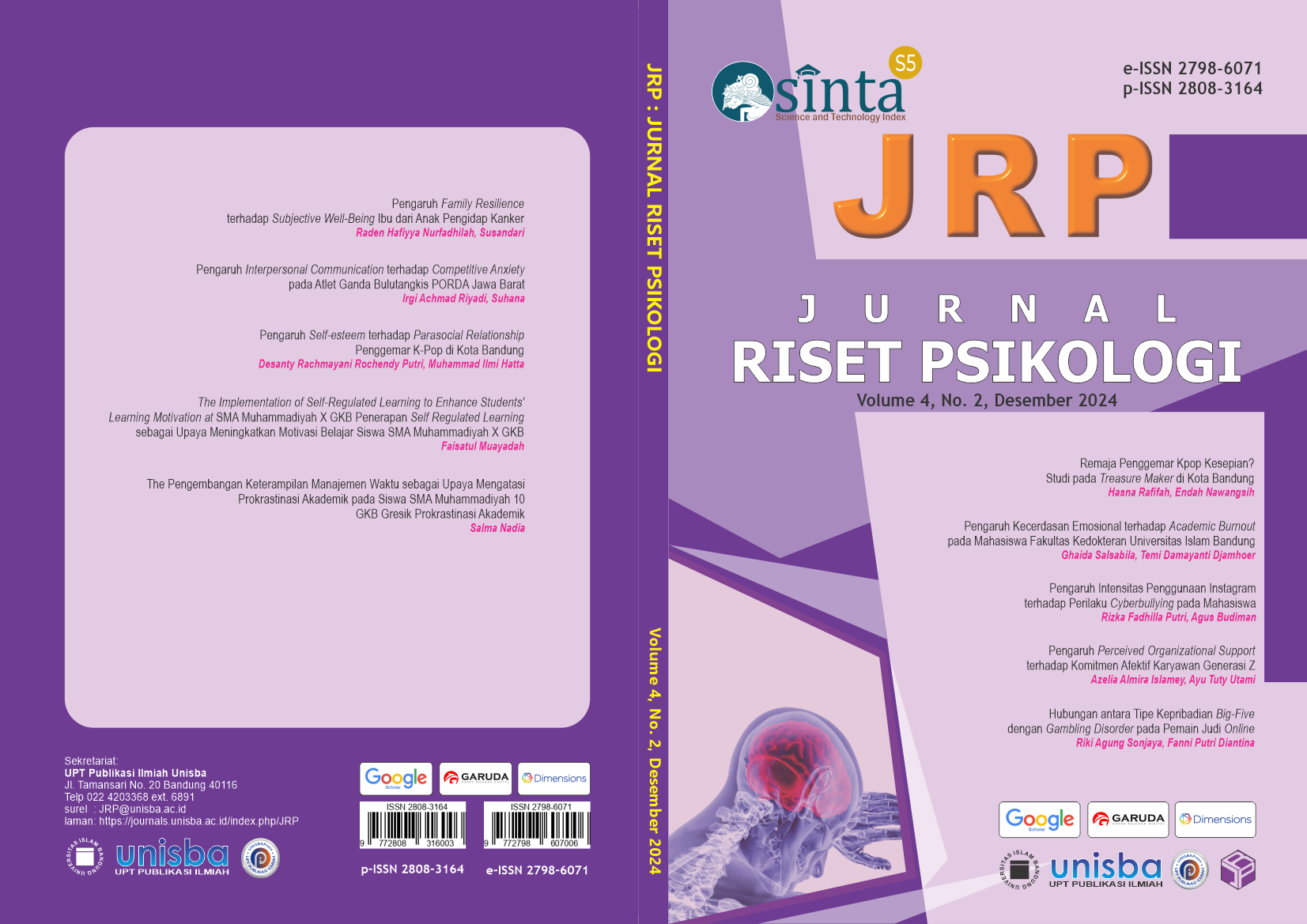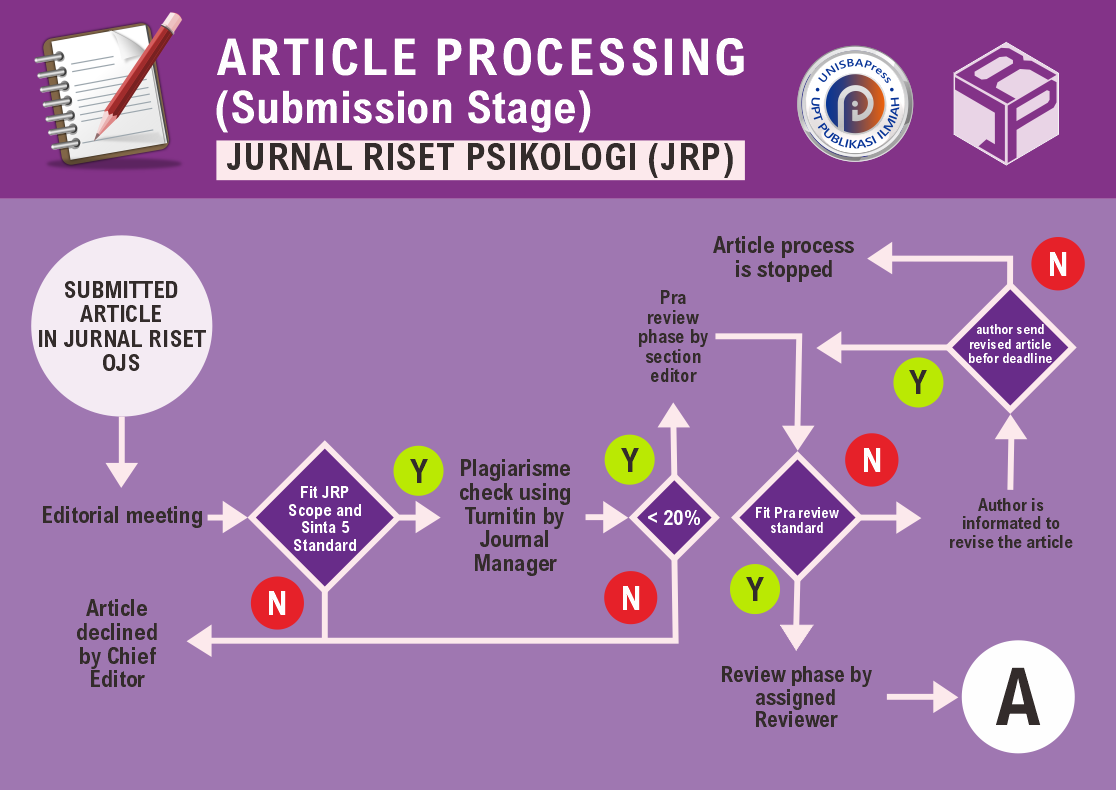Pengaruh Self-esteem terhadap Parasocial Relationship Penggemar K-Pop di Kota Bandung
DOI:
https://doi.org/10.29313/jrp.v4i2.5274Keywords:
Self-esteem, Parasocial Relationsip, K-Pop fansAbstract
Abstract. On the platform X parasocial relationship phenomenon, many claim to be stuck with their idols. Turner explained that individuals who are in the low self-esteem category are more likely to form a parasocial relationship. This study aims to determine how much self-esteem influences parasocial relationships among K-Pop fans in Bandung. The study used a quantitative research design with a causality method. The research sample consisted of 306 K-Pop fan respondents with a purposive sampling technique. The measuring instrument used was the Rosenberg Self-Esteem Scale which was constructed by Maroqi (2018) and the Multiple Parasocial Relationship Scale which the researcher adapted. The data analysis process was carried out using multiple regression techniques to measure the influence of self-esteem and its two aspects, self-competence and self-worthiness, on parasocial relationships. The results showed that self-esteem had an influence of 0.8% on parasocial relationships among K-Pop fans in Bandung. The self-competence aspect does not affect parasocial relationships and the self-worthiness aspect has an effect of 0.16%. This finding shows that the effect of self-esteem on parasocial relationships is in the low category. This indicates that other factors may have a greater influence on the development of this parasocial relationship.
Abstrak. Pada platform X fenomena hubungan parasocial, banyak yang mengaku terjebak dengan idolanya. Turner menjelaskan bahwa individu yang berada pada kategori self-esteem rendah memiliki kemungkinan yang lebih tinggi untuk menciptakan suatu hubungan parasosial. Penelitian ini bertujuan untuk mengetahui seberapa besar pengaruh self-esteem terhadap parasocial relationship terhadap penggemar K-Pop di Kota Bandung. Penelitian menggunakan desain penelitian kuantitatif dengan metode kausalitas. Sampel penelitian terdiri dari 306 responden penggemar K-Pop dengan teknik purposive sampling. Alat ukur yang digunakan adalah Rosenberg Self-Esteem Scale yang sudah dikonstruksikan oleh Maroqi (2018) dan Multiple Parasocial Relationship Scale yang diadaptasi oleh peneliti. Proses analisis data menggunakan teknik regresi berganda untuk mengukur pengaruh self-esteem dan kedua aspeknya yaitu self-competence dan self-worthiness terhadap parasocial relationship. Hasil penelitian menunjukkan bahwa self-esteem memiliki pengaruh sebesar 0,8% terhadap parasocial relationship terhadap penggemar K-Pop di Kota Bandung. Aspek self-competence tidak memberikan pengaruh pada parasocial relationship dan aspek self-worthiness memberikan pengaruh sebesar 0,16%. Temuan ini menunjukkan bahwa kontribusi self-esteem terhadap parasocial relationship rendah. Hal ini menunjukkan terdapat faktor lain yang mungkin memiliki pengaruh lebih besar terhadap perkembangan hubungan parasosial ini.
References
S. M. Kassin, S. Fein, H. R. Markus, and S. S. Brehm, Social Psychology, 10th ed. Boston: Cengage Learning, 2017.
U. Orth, R. Robins, and K. F. Widaman, “Life-span development of self-esteem and its effects on important life outcomes,” J Pers Soc Psychol, vol. 102, no. 6, pp. 1271–1288, 2012.
C. A. Hoffner, “Attachment to Media Characters,” encyclopedia. 2002. [Online]. Available: https://www.encyclopedia.com/media/encyclopedias-almanacs-transcripts-and-maps/attachment-media-characters
C. H. Jordan, V. Zeigler-Hill, and J. J. Cameron, “Self-Esteem,” in Encyclopedia of Personality and Individual Differences, Cham: Springer International Publishing, 2020, pp. 4738–4748. doi: 10.1007/978-3-319-24612-3_1169.
C. J. Mruk, Self-Esteem research, theory, and practice: Toward a positive psychology of self-esteem, 3rd ed. Springer Publishing Co, 2006.
N. Avisha, “Interaksi Parasosial, Fenomena Sosial yang Menyita Perhatian Masyarakat,” Kumparan. [Online]. Available: Interaksi Parasosial, Fenomena Sosial yang Menyita Perhatian Masyarakat
D. Emm, “Social media users seek one sided relationships to escape lockdown reality,” Kapersky. [Online]. Available: https://www.kapersky.com/about/press-release/2021_social-media-users-seek-one-sided-relationships-to-escape-lockdown-reality-research-finds
C. A. Hoffner and B. J. Bond, “Parasocial relationships, social media, & well-being,” Curr Opin Psychol, vol. 45, p. 101306, Jun. 2022, doi: 10.1016/j.copsyc.2022.101306.
Yenisca Juniar and E. N. Nugrahawati, “Self Discrepancy pada Roleplayer K-Pop pada Komunitas Entertaiment ‘X’ di Twitter,” Jurnal Riset Psikologi, vol. 1, no. 1, pp. 18–25, Jul. 2021, doi: 10.29313/jrp.v1i1.89.
CNN Indonesia, “Indonesia Jadi Negara dengan K-Poper Terbesar di Twitter,” CNN Indonesia. [Online]. Available: https://www.cnnindonesia.com/hiburan/20220126202028-227-741687/indonesia-jadi-negara-dengan-k-poper-terbesar-di-twitter/1
T. Forster, The Oxford Handbook of Parasocial Experiences, Rebecca. Oxford University Press, 2023.
A. Sagita and D. Kadewandana, “Hubungan Parasosial di Media Sosial: Studi pada fandom army di twitter,” CoverAge: Journal of Strategic Communication, vol. 8, no. 1, pp. 45–58, 2017.
R. R. P. Andennisa, “Hubungan Antara Parasocial Relationship dengan Self-Esteem Pada Penggemar K-Pop: Studi Korelasional pada Peserta Gathering GOT7,” Universitas Pendidikan Indonesia, Bandung, 2019.
A. Hanifah, “Indonesian Gen Z Work Values, Preference between Startups and Corporations, and Intention to Apply,” Jurnal Ekonomi dan Kewirausahaan West Science, vol. 1, no. 3, pp. 236–245, 2024.
N. Maroqi, “Uji Validitas Konstruk Pada Instrumen Rosenberg Self Esteem Scale Dengan Metode Confirmatory Factor Analysis (CFA),” Jurnal Pengukuran Psikologi dan Pendidikan Indonesia (JP3I), vol. 7, no. 2, pp. 92–96, Jul. 2019, doi: 10.15408/jp3i.v7i2.12101.
M. Möri and A. Fahr, “Parasocial interactions with media characters: the role of perceived and actual sociodemographic and psychological similarity,” Front Psychol, vol. 14, Dec. 2023, doi: 10.3389/fpsyg.2023.1297687.
H. O. Taylor, T. K. M. Cudjoe, F. Bu, and M. H. Lim, “The state of loneliness and social isolation research: current knowledge and future directions,” BMC Public Health, vol. 23, no. 1, p. 1049, Jun. 2023, doi: 10.1186/s12889-023-15967-3.
R. Tukachinsky, N. Walter, and C. J. Saucier, “Antecedents and Effects of Parasocial Relationships: A Meta-Analysis,” Journal of Communication, vol. 70, no. 6, pp. 868–894, Dec. 2020, doi: 10.1093/joc/jqaa034.













